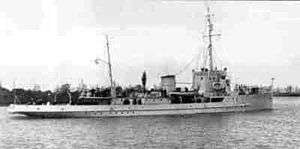ARA Fournier (M-5)
ARA Fournier (M-5) was a Bouchard-class minesweeper of the Argentine Navy. She was in service from 1940 until her sinking in 1949.
 Stern quarter view of ARA Fournier | |
| History | |
|---|---|
| Name: | Fournier |
| Builder: | Sanchez Shipyard, San Fernando |
| Launched: | 1939 |
| Commissioned: | 1940 |
| Identification: | Pennant number M-5 |
| Fate: | Ran aground and sank 4 October 1949 |
| General characteristics | |
| Class and type: | Bouchard-class minesweeper |
| Displacement: |
|
| Length: | 59.00 m (193 ft 7 in) oa |
| Beam: | 7.30 m (23 ft 11 in) |
| Draught: | 2.27 m (7 ft 5 in) |
| Propulsion: |
|
| Speed: | 15 knots (28 km/h; 17 mph) |
| Range: | 3,000 nautical miles (5,600 km; 3,500 mi) at 10 knots (19 km/h; 12 mph) |
| Endurance: | 50 long tons (51 t) fuel oil |
| Complement: | 62 |
| Armament: |
|
Design and description
The Bouchard-class minesweepers were the first large warships built in Argentina. They were intended to complement and eventually replace the Argentine Bathurst-class ships purchased from Germany after World War I.[1]
The Bouchard class was based on the Bathurst-class design, with diesel engines instead of steam engines and larger calibre main armament. However, these ships had poor stability, which eventually led to the loss of Fournier in 1949.[1]
The minesweepers were 59.00 m (193 ft 7 in) long overall and 49.99 m (164 ft 0 in) between perpendiculars with a beam of 7.30 m (23 ft 11 in) and a draught of 2.27 m (7 ft 5 in). The Bouchard class had a standard displacement of 450 long tons (457 t) and 520 long tons (528 t) at full load. They were powered by 2-cycle MAN diesel engines turning two shafts rated at 2,000 brake horsepower (1,500 kW). They had capacity for 50 long tons (51 t) of fuel oil, a maximum speed of 15 knots (28 km/h; 17 mph) and had a range of 3,000 nautical miles (5,600 km; 3,500 mi) at 10 knots (19 km/h; 12 mph).[2][3][n 1]
The ships were armed with two single-mounted 99 mm (3.9 in)/47 calibre guns.[n 2] For anti-aircraft defence, the minesweepers were equipped with one twin 40 mm (1.6 in) mount. They also carried two 7.65 mm (0.301 in) machine guns and were initially equipped with two depth charges.[2][4] The Bouchard class had a complement of 62.[3]
Service history

Fournier was built at the Sanchez shipyard in San Fernando.[5] She was launched in 1939, and handed over from the shipyard on 13 October 1940.[5][6]
On 21 September 1949, Fournier departed Río Gallegos for Ushuaia.[6] The minesweeper never made contact again, and was declared missing on 28 September.[6] She was later determined to have sunk on or around 4 October after striking a rock in the Magellan Straits, about 60 nautical miles (110 km) south of Punta Arenas.[5][7] All hands on board, initially reported as 60[6] but later established to be 77, were lost.[7]
Footnotes
- Chesneau has the maximum speed listed as 16 knots (30 km/h; 18 mph).
- The 47 calibre denotes the length of the gun. This means that the length of the gun barrel is 47 times the bore diameter.
Citations
- "Rastreadores" [Minesweepers]. Histarmar - Historia y Arqueología Marítima (in Spanish). Argentina: Fundación Histarmar. Retrieved 2016-12-03.
- Blackman, p. 126.
- Chesneau, p. 421.
- McMurtrie, p. 115.
- "Fournier (6111167)". Miramar Ship Index. Retrieved 17 November 2018.
- "Argentine Warship Gone". The New York Times. 29 September 1949. Retrieved 17 November 2018.
- Nash, p. 703.
Bibliography
- Blackman, Raymond V. B., ed. (1953). Jane's Fighting Ships 1953–54. London: Sampson, Low and Marston. OCLC 913556389.
- Chesneau, Roger, ed. (1980). Conway's All the World's Fighting Ships 1922–1946. Greenwich, UK: Conway Maritime Press. ISBN 0-85177-146-7.
- McMurtrie, Francis E., ed. (1943) [1942]. Jane's Fighting Ships 1942. London: Sampson Low, Marston & Co. OCLC 28197961.
- Nash, Jay Robert (1976). Darkest Hours: A Narrative Encyclopedia of Worldwide Disasters From Ancient Times to the Present. Lanham, Maryland: Rowman & Littlefield. ISBN 978-1-59077-526-4.
Further reading
- Arguindeguy, Pablo (1972). Apuntes sobre los buques de la Armada Argentina (1810-1970) (in Spanish). Buenos Aires, Argentina: Comando en Jefe de la Armada.
- LA PERDIDA DEL A.R.A. "FOURNIER" - "Histarmar" website (accessed 2018-12-26)